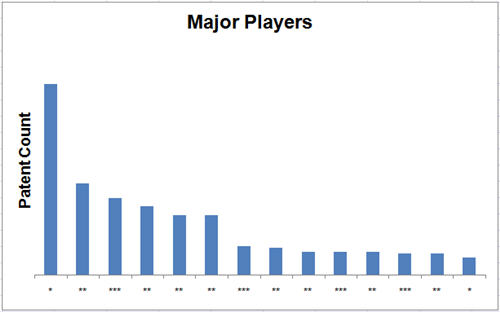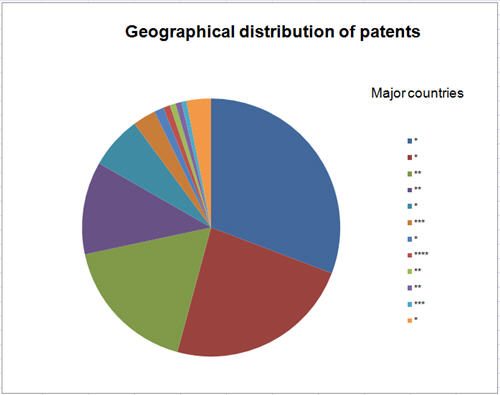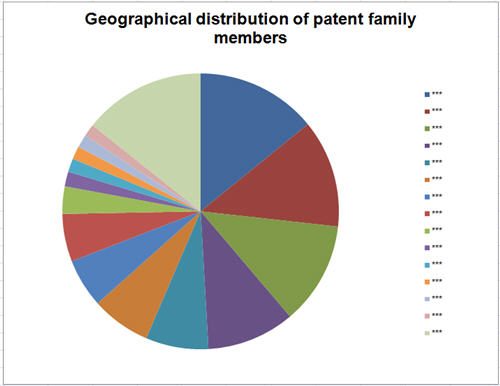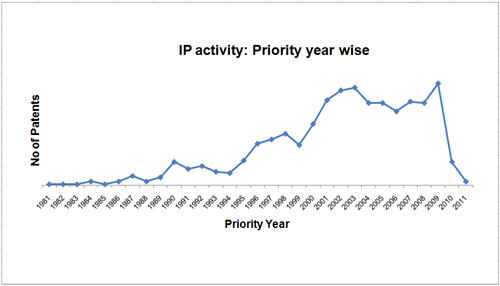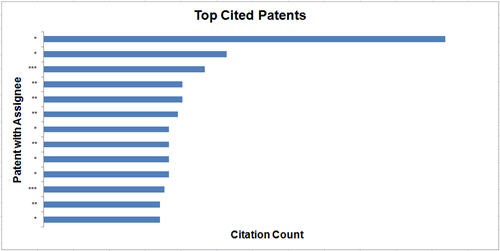Difference between revisions of "Gut biology and probiotic microorganisms in food template"
(→'''Objective''') |
|||
| Line 1: | Line 1: | ||
== '''Objective''' == | == '''Objective''' == | ||
| − | To create a | + | To create a technology landscape report on '''Gut Biology and Probiotic microorganisms in food''' |
| + | |||
| + | *Finding out the innovative market players in this technology area. | ||
| + | *Intellectual Property that these players hold is taken as a measure of their technological prowess in this particular area. | ||
| + | *Patents are used to point out the innovative and technologically advanced market players. | ||
==Search methodology== | ==Search methodology== | ||
Revision as of 01:59, 14 December 2011
Contents
Objective
To create a technology landscape report on Gut Biology and Probiotic microorganisms in food
- Finding out the innovative market players in this technology area.
- Intellectual Property that these players hold is taken as a measure of their technological prowess in this particular area.
- Patents are used to point out the innovative and technologically advanced market players.
Search methodology
| Search strategy | 1. Various keywords are retrieved for conducting the search related to gut biology and probiotics in food from pubmed mesh, relevant patents, scientific articles and thesaurus. 2. The database used for patent search is Thomson innovation. |
| Keywords | Gut biology, Probiotics, food, etc. |
Background
Definition
Etymologically, the term probiotic appears to be a composite of the Latin preposition pro ("for") and the Greek adjective βιωτικός (biotic), the latter deriving from the noun βίος (bios, "life").Miller et al British Journal of Nutrition, 2003 Lilly and Stillwell coined the term probiotic in 1965 and defined it as "a substance produced by one microorganism stimulating the growth of another microorganism" and understood a probiotic as opposite to an antibiotic.Rusch 2002 Over the course of time various definitions of probiotics have surfaced and the internationally adopted FAO/WHO definition was coined in 2001 which describes probiotics as
"Live microorganisms which when administered in adequate amounts confer a health benefit on the host" FAO report 2002
The International Study Group on New Antimicrobial Strategies (ISGNAS), developed a concept for the detailed definition of probiotics in three categories.
1. Medical probiotics (drugs) - a microbial preparation which contains live and/or dead microorganisms including their components and products determined to be employed as a drug for therapeutic purposes.
2. Pharmaceutical probiotics (food supplements) - a microbial preparation designed for manufacture of food supplements.
3. Alimentary probiotics (food) - a microbial preparation designed for use in food fermentation or food production. The mode of action includes immunomodulation, host microflora modulation, and the modulation of metabolic processes. Rusch 2002
![]() Please click here to view the Common probiotic microorganisms
Please click here to view the Common probiotic microorganisms
Science behind probiotics
An organism may be classified as a probiotic(in human beings) based on the following criteria.
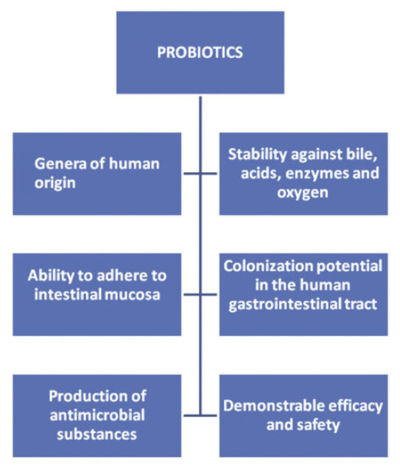
Of the probiotic microbes, the genera Bifidobacter and Lactobacillus are very prevalent. They restore the normal intestinal microflora after antibiotic treatment, produce digestive enzymes, improves food digestibility, suppresses food-borne pathogens.
Probiotics as food
Probiotics essentially work by helping to maintain and replenish these colonies of beneficial bacteria. They can be ingested through a variety of means, including daily capsules, yogurt shots, or enhanced dairy products. Capsules of probiotics are similar to capsules of any nutrient, and contain live bacteria within an easily digestible shell. Small yogurt shots, which contain less than one ounce of yogurt infused with high numbers of probiotics, can be taken once a day instead of the capsule. Significant numbers of probiotics have also become included in many types of milk, cheeses, and yogurts to help keep numbers of gut flora high. Probiotic effects ehow.com
Health benefits of probiotics
The world is full of microorganisms (including bacteria), and so are people's bodies -- in and on the skin, in the gut, and in other orifices. Friendly bacteria are vital to proper development of the immune system, to protection against microorganisms that could cause disease, and to the digestion and absorption of food and nutrients. Each person's mix of bacteria varies. Interactions between a person and the microorganisms in his body, and among the microorganisms themselves, can be crucial to the person's health and well-being.
This bacterial "balancing act" can be thrown off in two major ways:
1. By antibiotics, when they kill friendly bacteria in the gut along with unfriendly bacteria. Some people use probiotics to try to offset side effects from antibiotics like gas, cramping, or diarrhea. Similarly, some use them to ease symptoms of lactose intolerance -- a condition in which the gut lacks the enzyme needed to digest significant amounts of the major sugar in milk, and which also causes gastrointestinal symptoms.
2. "Unfriendly" microorganisms such as disease-causing bacteria, yeasts, fungi, and parasites can also upset the balance. Researchers are exploring whether probiotics could halt these unfriendly agents in the first place and/or suppress their growth and activity in conditions like:
- Infectious diarrhea
- Irritable bowel syndrome
- Inflammatory bowel disease (e.g., ulcerative colitis and Crohn's disease)
- Infection with Helicobacter pylori (H. pylori), a bacterium that causes most ulcers and many types of chronic stomach inflammation
- Tooth decay and periodontal disease
- Vaginal infections
- Stomach and respiratory infections that children acquire in daycare
- Skin infections
- TumoursProbiotics medicinenet.com
Probiotics contribute to well-being in various ways as shown in the figure

Concept Table
Class code definitions
Click Here for Class-Codes and their definitions
Search Strategy
- Search Engine: Thomson Innovation
- Databases covered: US, Europe, German, Japanese and Korean applications and granted patents
- Coverage: Title, Abstract and Claims
- Timeline: 1991- 20th Sep 2011
| S.No | Concept | Search Query | Number of hits |
| English keyword search | |||
| 1 | Keywords for probiotic + IPC class codes for food | (probiotic*1 OR synbiotic*1 OR symbiotic*1 OR (probiotic ADJ2 (microorganism*1 OR micro ADJ2 organism*1 or microbe*1)) OR AND A23C009123 | ### |
| 2 | Keywords for probiotic + US class codes for food | (probiotic*1 OR synbiotic*1 OR symbiotic*1 OR (probiotic ADJ2 (microorganism*1 OR micro ADJ2 organism*1 or microbe*1)) AND 424439 OR 426620 OR 426623 OR 426625 | ### |
| 3 | 1 OR 2 | ### | |
| 4 | Keywords for food + IPC class codes for probiotic | Food OR (Food ADJ2 stuff*1) OR Feed OR (Feed ADJ2 stuff*1)AND C12R000146 OR A61K003574 OR A23C000912 OR C12R001225 | ### |
| 5 | Keyword for food + US class code for probiotic | Food OR (Food ADJ2 stuff*1) OR Feed OR (Feed ADJ2 stuff*1) AND 424931 OR 424933 OR 42409344 OR 42409345 | ### |
| 6 | 4 OR 5 | ### | |
| 7 | Final English query- 3 OR 6 | ### | |
| German keyword search | |||
| 8 | Keywords for probiotic + IPC class codes for food | (Probiotischen OR symbioti*3 OR synbiotik*2 OR Probiotika OR (probiotischer ADJ2 organismus) OR (probiotischer ADJ2 organismen) OR (nützlichen ADJ2 Mikroben)AND A23C009123 | ### |
| 9 | Keywords for food + IPC class codes for probiotic | (Säuglingsanfangsnahrung OR Säuglingsfertignahrung OR Nahrungsergänzung) AND C12R000146 OR A61K003574 OR A23C000912 OR C12R001225 | ### |
| 10 | Final German query- 8 OR 9 | ### | |
| French keyword search | |||
| 11 | Keyword for probiotic + IPC class codes for food | (probiotique OR synbioti*4 OR symbiotic*4 OR (des ADJ2 probiotique) OR (les ADJ2 probiotique) OR (de ADJ2 probiotique) OR probiotiques OR ( des ADJ2 probiotiques) OR (les ADJ2 probiotiques) OR (de ADJ2 probiotiques)AND A23C009123 | ### |
| 12 | Keywords for food + IPC class codes for probiotic | (((formule ADJ2 pour) ADJ2 bébé) OR ((préparations ADJ2 pour) ADJ2 nourrissons) OR (((les ADJ2 préparations) ADJ2 pour) ADJ2 nourrissons) OR (((des ADJ2 préparations) ADJ2 pour) ADJ2 nourrissons))) AND C12R000146 OR A61K003574 OR A23C000912 OR C12R001225 | ### |
| 13 | Final French query- 11 OR 12 | ### | |
| Search with Japanese F terms | |||
| 14 | Keywords for probiotic + Japanese F term for food | (probiotic*1 OR synbiotic*1 OR symbiotic*1 OR (probiotic ADJ2 (microorganism*1 OR micro ADJ2 organism*1 or microbe*1)) AND 4C087CA07 OR 4B035LG44 | ### |
| 15 | Keywords for food + Japanese F-term for probiotic | Food OR (Food ADJ2 stuff*1) OR Feed OR (Feed ADJ2 stuff*1) AND 4B001AC31 OR 4B001AC50 | ### |
| 16 | Final query with F-terms- 14 OR 15 | ### | |
| 17 | FINAL SEARCH QUERY- 7 OR 10 OR 13 OR 16 | ### | |
Taxonomy
Relevant patents
| S.No | Publication No | Title | Abstract | Date of patent | Inventors | Assignee |
| 1 | US20070286888 | Additive For Feeds And Feed Containing The Same | An additive for feeds is provided which is efficacious in preventing and ameliorating digestive disorders such as diarrhea occurring as the side effects of the administration of antibiotics and a feed containing same. More specifically, an additive for feeds which comprises (A) Lactobacillus equi cells and (B) cells of at least one bacterium selected from the group consisting of Lactobacillus salivarius, Lactobacillus crispatus and Lactbacillus johnsonii. | 13-Dec-07 | Kado; Yukiko ; Morotomi; Masami. | Kabushiki Kaisha Yakult Honsha |
| 2 | US7906112 | Canine probiotic Lactobacilli | According to the invention there is provided a strain of lactic acid bacteria of the genus Lactobacilli obtainable by isolation from resected and washed canine gastrointestinal tract having a probiotic activity in animals. Methods of use and compositions comprising the Lactobacilli of the present invention are also provided. | 3-Sep-03 | Reid; Gregor, Bruce; Andrew W. , Han; Victor | Urex Biotech, Inc. |
| 3 | US7288245 | Composition having immunoregulating activities | The invention provides a composition comprising novel lactic acid bacteria having immunoregulating activities. Specifically, the invention provides food, drinks or medicaments containing novel lactic acid bacteria separated from "Shibazuke," one kind of traditional Kyoto pickles, and having immunoregulating activities. The lactic acid bacteria belong to Lactobacillus pentosus and have a weak assimilating activity or no assimilating activity for glycerol. | 30-Oct-07 | Nonaka; Yuji, Izumo; Takayuki, Iida; Keiko | Suntory Limited |
| 4 | US20060121015 | Probiotic bifidobacterium strains | A Bifidobacterium strain, AH208, AH209, AH210, AH211, AH212 or AH214 or mutants or variants thereof are useful in the prophylaxis and/or treatment of inflammatory activity especially undesirable gastrointestinal inflammatory activity, such as inflammatory bowel disease or irritable bowel syndrome. | 8-Jun-06 | Collins; John Kevin; O’Sullivan; Gerald Christopher; O’Mahony; Liam; Shanahan; Fergus;Kiely; Barry | Alimentary Health Limited |
Sample Patent Analysis Sheet
Click here to download the sample patent analysis sheet
Assignee analysis and IP Activity
Top Assignees
- NESTLE SA, AJINOMOTO and VALIO LTD are the among the major players in the field of Probiotic foods
- NESTLE SA, AJINOMOTO and VALIO LTD are the among the major players in the field of Probiotic foods
Geographical distribution
- Based on patent number
- Including family members
IP Activity
Top Cited patents
- Patents with the maximum number of forward citations were determined and the graph shows the top 13 patents with corresponding assignees.
Patent to product mapping
| S.No | Patent no | Title | Assignee | Products | Snapshot |
| 1 | US20110014248A1 | Cosmetic use of microorganism(s) for the treatment of scalp disorders | NESTLE SA | INNEOV HAIR HEALTH DS DANDRUFF |
|
| 2 | WO2011012655A1 | Nutritional composition for breast-fed infants or pets with probiotics and selected nutrients | NESTLE SA | FortiFlora® Canine Nutritional Supplements |
|
| 3 | US5603930A | Lactobacillus johnsonii CNCM I-1225 | NESTLE SA | LC1 yoghurt |
|
